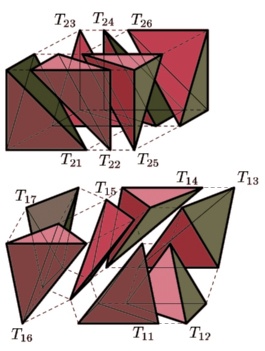|
|
|
|
Research project:
Klein polyhedra and multidimensional continued
fractions
|
|

The problem of generalizing ordinary continued fractions to the
higher-dimensional case was posed by C. Hermite in 1839. A large
number of attempts to solve this problem lead to the birth of
several different remarkable theories of multidimensional
continued fractions.
We consider the geometrical generalization of ordinary continued
fractions to the multidimensional case presented by F. Klein in
1895. Consider a set of n+1 hyperplanes of real (n+1)-dimensional
space passing through the origin in general position. Let us
choose an arbitrary orthant in the complement to the union of
these hyperplanes. The boundary of the convex hull of all integer
points except the origin in the closure of the orthant is called
the sail. The set of all sails is called the n-dimensional
continued fraction associated to the given n+1 hyperplanes. So any
sail is a special polygonal surface with vertices in integer
points.
Multidimensional continued fractions in the sense of Klein have
many connections with other branches of mathematics. For example,
J.-O. Moussafir and O. N. German studied the relations between the
sails of multidimensional continued fractions and Hilbert bases.
H. Tsuchihashi found the connection between periodic
multidimensional continued fractions and multidimensional cusp
singularities, which generalizes the relationship between ordinary
continued fractions and two-dimensional cusp singularities. M. L.
Kontsevich and Yu. M. Suhov discussed the statistical properties
of the boundary of a random multidimensional continued fraction.
The combinatorial topological generalization of Lagrange theorem
was obtained by E. I. Korkina and further developed by O. N. German,
and its algebraic generalization by G. Lachaud.
We are aiming to establish and to study relations between theory
of geometric multidimensional continued fractions from one side
and approximation theory and classification of SL(3,Z)-matrices
from the other. We are also interested in questions on
multidimensional generalizations of Gauss-Kuzmin statistics and
other combinatorial properties of the polyhedral faces of sails.
|
| Publications |
-
O. N. Karpenkov and A. M. Vershik.
Rational approximation of maximal commutative subgroups of GL(n,R).
J. Fixed Point Theory Appl. 7/1 (2010), 241-263.
[MR], [doi].
-
O. Karpenkov.
Continued fractions and the second Kepler law.
Manuscripta Mathematica 134 (2011), 157-169.
[MR], [doi], [arxiv:0911.2791].
-
O. Karpenkov.
On
determination of periods of geometric continued fractions for two-dimensional
algebraic hyperbolic operators.
Math. Notes 88/1-2 (2010), 28-38, Russian version: Mat.
Zametki, 88(1), (2010), 30--42.
[doi].
-
O. Karpenkov.
On
irrational lattice angles.
Funct. Anal. Other Math. 2/2-4 (2009), 221-239.
[Zbl], [MR], [doi].
-
O. Karpenkov.
Constructing multidimensional periodic continued fractions in the sense of
Klein.
Math. Comp. 78/267 (2009), 1687-1711.
[MR], [doi], [arxiv:math/0411031].
-
O. Karpenkov.
Elementary notions of lattice trigonometry.
Math. Scand. 102/2 (2008), 161-205.
[Zbl], [MR].
-
O. Karpenkov.
Completely empty pyramids on integer lattices and two-dimensional faces of
multidimensional continued fractions.
Monatsh. Math. 152/3 (2007), 217-249.
[Zbl], [MR], [doi], [arxiv:math/0510482].
-
O. Karpenkov.
On a
criterion for the existence and uniqueness of an integer triangle with given
angles.
Russian Math. Surveys 61/6 (2006), 1178-1179.
[Zbl], [MR], [doi].
-
O. Karpenkov.
Three
examples of three-dimensional continued fractions in the sense of
Klein.
C. R. Math. Acad. Sci. Paris 343/1 (2006), 5-7.
[Zbl], [MR], [doi], [arxiv:math/0601493].
-
O. Karpenkov.
Classification of three-dimensional multistoried completely hollow convex
marked pyramids.
Russian Math. Surveys 60 (2005), 165-166.
[Zbl], [MR], [doi].
-
O. Karpenkov.
On
two-dimensional continued fractions of hyperbolic integer matrices with small
norm.
Russian Math. Surveys 59/5 (2004), 959-960.
[Zbl], [MR], [doi].
-
O. Karpenkov.
On the
triangulations of tori associated with two-dimensional continued fractions of
cubic irrationalities.
Funct. Anal. Appl. 38/2 (2004), 102-110, Russian version:
Funkt. Anal. Prilozh. 38 (2004), 28-37.
[Zbl], [MR], [doi].
-
O. Karpenkov.
Integer
conjugacy classes of SL(3,Z) and Hessenberg matrices.
Technical Report 0711.0830v2, ArXiv, September 2009.
[arxiv:0711.0830v2].
|
| Other References |
-
V. I. Arnold.
Continued fractions.
Moscow Center of Continuous Mathematical Education, Moscow, 2002.
-
V. I. Arnold.
Higher-dimensional continued fractions.
Regul. Chaotic Dyn. 3/3 (1998), 10-17, J. Moser at 70 (Russian).
[MR].
-
O. N. German.
Sails and Hilbert bases.
Tr. Mat. Inst. Steklova 239/Diskret. Geom. i Geom. Chisel
(2002), 98-105.
[MR].
-
F. Klein.
Ueber eine geometrische Auffassung der gewöhnlichen
Kettenbruchentwicklung.
Nachr. Ges. Wiss. Göttingen Math-Phys. Kl. 3/3 (1895),
352-357.
-
F. Klein.
Sur une représentation géométrique de développement en fraction
continue ordinaire.
Nouv. Ann. Math. 15/3 (1896), 327-331.
-
M. L. Kontsevich and Y. M. Suhov.
Statistics of Klein polyhedra and multidimensional continued fractions.
In Pseudoperiodic topology, volume 197 of Amer. Math. Soc. Transl.
Ser. 2, pages 9-27. Amer. Math. Soc., Providence, RI, 1999.
[MR].
-
E. I. Korkina.
The simplest 2-dimensional continued fraction.
J. Math. Sci. 82/5 (1996), 3680-3685, Topology, 3.
[MR].
-
E. I. Korkina.
Two-dimensional continued fractions. The simplest examples.
Trudy Mat. Inst. Steklov. 209/Osob. Gladkikh Otobrazh. s Dop.
Strukt. (1995), 143-166.
[MR].
-
E. Korkina.
La périodicité des fractions continues multidimensionnelles.
C. R. Acad. Sci. Paris Sér. I Math. 319/8 (1994), 777-780.
[MR].
-
G. Lachaud.
Voiles et polyhedres de Klein.
Act. Sci. Ind. Hermann, 2002.
176 pp.
-
Z.-O. Mussafir.
Sails and Hilbert bases.
Funktsional. Anal. i Prilozhen. 34/2 (2000), 43-49, 96.
[MR].
-
H. Tsuchihashi.
Higher-dimensional analogues of periodic continued fractions and cusp
singularities.
Tohoku Math. J. (2) 35/4 (1983), 607-639.
[MR].
|

